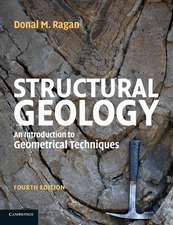Geomorphological Mapping: Methods and Applications: Developments in Earth Surface Processes, cartea 15
Autor Mike J. Smith, James S. Griffiths Editat de Paolo Paronen Limba Engleză Hardback – 31 oct 2011
- Growth of interest in geomorphological mapping and currently no texts comprehensively cover this topic
- Extensive case studies that will appeal to professionals, academics and students (with extensive use of diagrams, potentially colour plates)
- Brings together material on digital mapping (GIS and remote sensing), cartography and data sources with a focus on modern technologies (including GIS, remote sensing and digital terrain analysis)
- Provides readers with summaries of current advances in methodological/technical aspects
- Accompanied by electronic resources for digital mapping
Preț: 877.08 lei
Preț vechi: 1222.03 lei
-28% Nou
Puncte Express: 1316
Preț estimativ în valută:
167.83€ • 182.87$ • 141.42£
167.83€ • 182.87$ • 141.42£
Carte tipărită la comandă
Livrare economică 16-30 aprilie
Preluare comenzi: 021 569.72.76
Specificații
ISBN-13: 9780444534460
ISBN-10: 0444534466
Pagini: 610
Ilustrații: Illustrations, maps
Dimensiuni: 152 x 229 x 33 mm
Greutate: 1.13 kg
Ediția:New.
Editura: ELSEVIER SCIENCE
Seria Developments in Earth Surface Processes
ISBN-10: 0444534466
Pagini: 610
Ilustrații: Illustrations, maps
Dimensiuni: 152 x 229 x 33 mm
Greutate: 1.13 kg
Ediția:New.
Editura: ELSEVIER SCIENCE
Seria Developments in Earth Surface Processes
Public țintă
Researchers and professionals in geomorphology, engineering geologists and applied geologyCuprins
Section 1 – Geomorphological Mapping1. Introduction to Applied Geomorphological Mapping2. Old and New Trends in Geomorphological and Landform Mapping3. Nature and Aims of Geomorphological Mapping4. Makers and Users of Geomorphological Maps5. Geomorphological Contributions to Landslide Risk Assessment: Theory and PracticeSection 2 – Techniques in Applied Geomorphological Mapping6. Geomorphological Field Mapping7. Data Sources8. Digital Mapping: Visualisation, Iinterpretation and Quantification of Landforms9. Cartography: Design, Symbolisation and Visualisation of Geomorphological Maps10. Semi-Automated Identification and Extraction of Geomorphological Features using Digital Elevation DataSection 3 – Case Studies11. Mapping Ireland’s Glaciated Continental Margin Using Marine Geophysical Data12. Submarine Geomorphology: Quantitative Methods Illustrated with the Hawaiian Volcanoes 13. Marine Geomorphology: Geomorphological Mapping and the Study of Submarine Landslides14. The Cherry Garden Landslide, Etchinghill Escarpment, Southeast England. 15. The Application of Geomorphological Mapping in the Assessment of Landslide Risk in Hong Kong16. A Geomorphological Map as a Tool for Assessing Sediment Transfer Processes in Small Catchments Prone to Debris-Flows Occurrence: A Case Study in the Bruchi Torrent (Swiss Alps)17. Geomorphological Assessment of Complex Landslide Systems Using Field Reconnaissance and Terrestrial Laser Scanning18. Digital Terrain Models From Airborne Laser Scanning for the Extraction of Natural and Anthropogenic Linear Structures19. Applied Geomorphic Mapping for Land Management in the River Murray Corridor, SE Australia20. Monitoring Braided River Change Using Terrestrial Laser Scanning and Optical Bathymeric Mapping21. Uses and Limitations of Field-Mapping of Lowland Glaciated Landscapes22. Mapping Late-Holocene Landscape Evolution and Human Impact – A Case-Study from Lower Khuzestan (SW Iran)23. Military Applied Geomorphological Mapping: Normandy Case Study24. Future Developments of Geomorphological Mapping
Recenzii
"Geomorphological Mapping: Methods and Applications is a practical textbook that is essential reading to students and professional practitioners wishing to embark on a geomorphological project in any discipline. It is the first book of its kind, in that it brings together many topics that are normally dealt with and taught separately. These include the practicalities of completing field mapping, through to data sources and how to interrogate them and process them in a GIS. The diagrams and maps provided as examples are of a high standard. It is easily read and logically arranged, with clear co-operation between the editors and contributors." --Quaternary Science Reviews
"This text explains the concepts, characteristics, makers and users of, and trends in, how modern geomorphological mapping can be applied to solve complex problems in land management, including landslide risk assessment, resource location, and changes in landforms. Following a historical overview of trends in field-based geomorphological mapping, Smith (geography, geology, and the environment, Kingston U., UK) and colleagues in the UK and the Netherlands present new digital tools and techniques, e.g., remote sensing, WebGIS, that have resulted in the use of 'non-subjective' mapping in applied research that now informs cartography, geographic information systems, and terrain analysis. The handbook includes international case studies illustrated with diagrams and color plates that exemplify the diverse applications, current limitations and potential of this methodology." --Reference and Research Book News, October 2012
"This text explains the concepts, characteristics, makers and users of, and trends in, how modern geomorphological mapping can be applied to solve complex problems in land management, including landslide risk assessment, resource location, and changes in landforms. Following a historical overview of trends in field-based geomorphological mapping, Smith (geography, geology, and the environment, Kingston U., UK) and colleagues in the UK and the Netherlands present new digital tools and techniques, e.g., remote sensing, WebGIS, that have resulted in the use of 'non-subjective' mapping in applied research that now informs cartography, geographic information systems, and terrain analysis. The handbook includes international case studies illustrated with diagrams and color plates that exemplify the diverse applications, current limitations and potential of this methodology." --Reference and Research Book News, October 2012



















